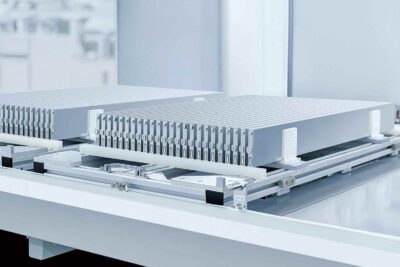Croda opens process window for water-based cathode slurry
Croda’s dispersant expertise opens the processing window for water-based cathode slurries, which makes it easier to manufacture more sustainable batteries.
The production of lithium ion batteries keeps expanding globally and is expected to reach 2000 GWh of installed capacity by 2030. Most battery manufacturing processes currently use NMP (N-methyl-2-pyrrolidone) as a solvent for cathode slurry formulation and NMP is classified as a substance of very high concern (SVHC) according to the EU REACH regulation.
Battery manufacturers will face significant legislative risk if they continue to operate under the assumption that NMP use in the industry will continue without further regulation in the years to come. Industry disruptors and innovators are therefore shifting their focus to optimise and improve aqueous cathode slurries that do not contain NMP.
Solid electrolytes are known to improve the performance of Li-ion battery cathodes. For solid oxide electrolyte to provide the same benefits in water based systems, it must first be compatible and chemically stable in water whilst being well dispersed.
In one such instance, OHARA INC. in Japan has developed an oxide-type solid electrolyte powder. This powder, called LICGC™ PW-01 can boost rate performance of the cathode at high C-rates when adopted in the current liquid lithium ion battery architecture. The reliability of high temperature energy storage is also enhanced when using LICGC™ PW-01. (Fig.1, Fig.2).

OHARA demonstrated that LICGC™ PW-01 has superior water resistance versus other solid-oxide electrolyte powders.
In developing LICGC™ PW-01 for water based cathode production, OHARA sought expertise from Croda to open the processing window. Croda have for many years developed a range of dispersant chemistries under the Hypermer™ KD brand for various markets and applications. This family of dispersants helps to overcome common issues in water-based electrode slurries, which include agglomeration and increased surface tension.
The synergistic effect of Croda’s dispersant and OHARA’s LICGC™ PW-01 technology allows battery manufacturers to formulate slurries with ease, due to the enhanced stability of the electrode components (Fig.3).
The dispersant technology developed by Croda also broadens the offering of LICGC™ PW-01, making it suitable for use in separator coatings for Li-ion batteries and solid-state battery slurries for easier processing.

About Croda www.croda.com
Established in 1925, Croda is the name behind sustainable, high performance ingredients and technologies in some of the world’s most successful brands: creating, making and selling speciality chemicals that are relied on by industries and consumers everywhere.
Croda is a FTSE 100 company with over 4,500 passionate and innovative employees, working across manufacturing sites and offices around the world with a shared Purpose to use Smart Science to Improve Lives™. As part of this Purpose, and with around two thirds of its organic raw materials already from bio-based sources, Croda has committed to be the most sustainable supplier of innovative ingredients, becoming Climate, Land and People Positive by 2030.
This article is a paid advertorial. The client is responsible for the content. If you are interested in booking an advertorial, please contact us via advertise@electrive.com.





0 Comments